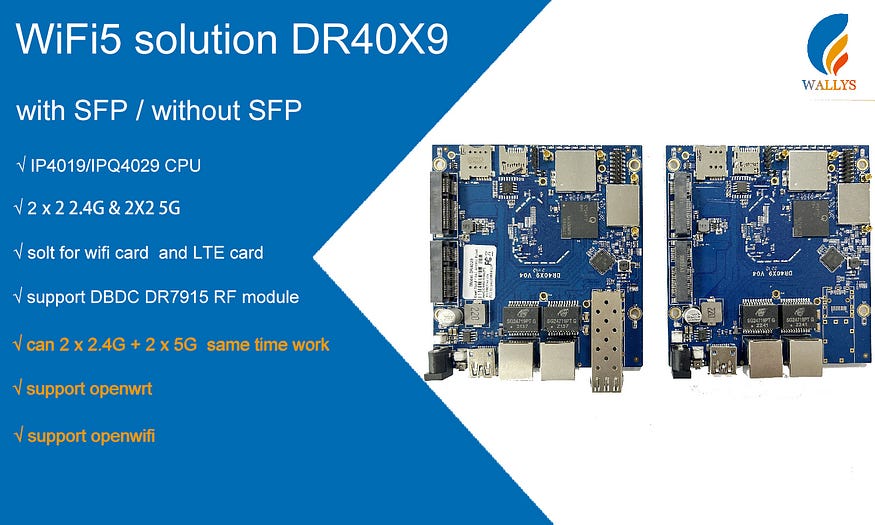With the growing popularity of wireless networks and the increasing number of devices, users demand broader WiFi coverage and more stable network performance. Traditional single-router WiFi networks often struggle with weak signals and unstable connections when covering large areas. To address these issues, Mesh networks have emerged as a solution, especially WiFi 5 routers based on IPQ4019/IPQ4029 chips, which offer efficient performance and Mesh functionality, making them ideal for homes and small to medium-sized office environments. This article will analyze the advantages of these routers from various perspectives.
1. Features of IPQ4019/IPQ4029 Chips
Qualcomm’s IPQ4019 and IPQ4029 chips are high-performance network processors designed for WiFi 5 (802.11ac), featuring:
- Dual-Core ARM Cortex A7 Processor: Provides sufficient processing power to support multitasking and high-traffic data processing.
- Efficient Wireless Performance: Supports dual-band (2.4GHz and 5GHz) frequencies, offering faster wireless speeds while connecting multiple devices.
- Low Power Consumption: Suitable for home and small business use, running for extended periods with low power consumption, saving energy.
- Built-in Network Security: Equipped with firewall, VPN, and multiple encryption technologies to ensure network security.
The high performance and versatility of IPQ4019/IPQ4029 provide a robust hardware foundation for Mesh networks, enabling efficient handling of multiple device connections.

2. Core Advantages of Mesh Networks
Mesh networks, formed by multiple router nodes, work together intelligently to cover a wider area. Compared to traditional WiFi networks, Mesh systems offer several key advantages:
Coverage and Stability
- Extended Coverage: Mesh networks can collaborate across multiple nodes to eliminate WiFi dead zones, ensuring comprehensive signal coverage in large homes, duplex buildings, and small to medium-sized office environments.
- Seamless Roaming: Thanks to the design of Mesh networks, devices can automatically connect to the nearest node while moving, providing a seamless network experience without signal interruptions.

Featuring with industrial-grade IPQ4019/IPQ4029 chipset
Integrated with 2x 2 5G high power Radio module and 2x2 2.4G high power Radio module
Support 4.940GHz to 5.825GHz Frequency Range
Support 2.400GHz to 2.482GHz
Support 2 x 5G MMCX Connectors and 2x2.4G MMCX
Support 5MHz/10MHz/20MHz/40MHz/80MHz Bandwidth
Support 11ABGN/AC
Support fixed data rate
RoHS compliance ensure a high level protection of human health and the environment from risks that can be posed by chemicals
Our Firmware supports all the modules of Quectel
Support Openwifi
Support QSDK
Support Openwrt
more information ,please contact: sales@wallystech.com
Performance and Load Balancing
- Efficient Data Processing: WiFi 5 routers based on IPQ4019/IPQ4029 chips have powerful data processing capabilities, intelligently distributing network traffic across multiple nodes to ensure efficient network operation.
- Load Balancing: When a node has too many connected devices, the Mesh system can automatically switch some devices to other nodes, preventing single-point overload and maintaining smooth operation throughout the network.
Easy Setup and Management
- Automatic Configuration: Mesh network devices often feature automatic configuration. Users only need to perform a simple initial setup, and other nodes will automatically connect to the main router, eliminating the need for complicated manual operations.
- Centralized Management: Many Mesh systems come with easy-to-use apps that allow monitoring and managing the entire network from a smartphone or computer, including firmware updates, device management, and network status monitoring.
Security and Redundancy
- Redundancy Design: Mesh networks provide redundancy through multiple nodes, ensuring that if one node fails, others can automatically take over, keeping the network running.
- Advanced Security Features: Thanks to the built-in security modules of IPQ4019/IPQ4029, Mesh systems can use the latest encryption protocols, ensuring the security of data transmission and protecting user privacy.
Adaptability to Smart Home Devices
- Multiple Device Connections: Modern homes often have numerous smart devices, and Mesh network systems can effectively handle multiple connections and allocate bandwidth efficiently, ensuring stable network connections for all devices.
3. Cost-Effectiveness of WiFi 5 Mesh Routers
Although WiFi 6 and WiFi 7 technologies are becoming more popular, their relatively high costs may deter many users. WiFi 5 Mesh routers based on IPQ4019/IPQ4029 chips strike a balance between cost and performance, making them an ideal choice for homes and small businesses. They can provide reliable connections and excellent performance while being more cost-effective than next-generation WiFi 6/7 devices.
Conclusion
WiFi 5 Mesh routers based on IPQ4019/IPQ4029 chips address the limitations of traditional WiFi routers in terms of large area coverage and multiple device connections through efficient hardware performance and intelligent Mesh network design. Whether for home users or small to medium-sized enterprises, Mesh systems can achieve more stable, wider coverage, and easier-to-manage wireless networks. These advantages, combined with reasonable cost-effectiveness, make them a practical and economical networking solution in today’s market.

Comments
Post a Comment